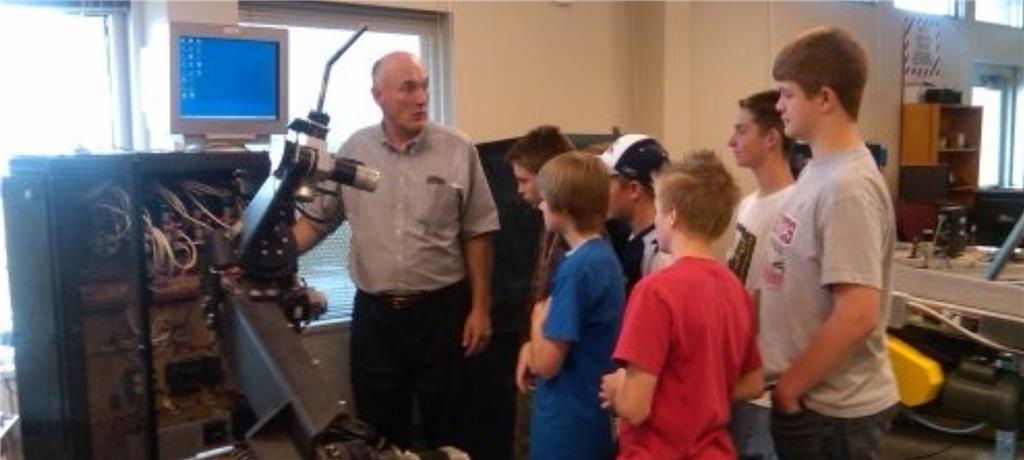Can I Use a Douloi Device as an EZ-B Controller for Inverse Kinematics in ARC?
I would like to know if the Synthiam ARC platform can support the use of Douloi devices as replacements for EZ-B controllers in an inverse kinematics setup. I have developed an industrial robot, as depicted in the provided images, utilizing two Douloi units connected through a fiber optic card to a Windows 486 desktop computer. This computer is presently running custom software developed in Pascal to manage the robot and log its movement paths.
I am considering migrating the robot control to Synthiam ARC, using the two Douloi units as my EZ-B controllers. Can ARC accommodate this configuration, and if so, what would I need to do to integrate these components effectively?
![Industrial Robot]




Below is some feedback and suggestions for integrating highvoltage DC motors with encoders (170 V) into your industrial arm robot using ARC.
Considerations for Industrial Motor Control
High Voltage & Current Handling:
Since your motors work at 170 V DC, you’ll need a controller or drive that is rated for industrial/high-power applications. Hobby-grade or EZ-B-native controllers won’t be sufficient.
Encoder/Feedback Support:
Because you need position feedback from encoders, the controller must support closed-loop control to reliably drive the motors and report their status back to ARC.
Communication Interface:
ARC communicates well over serial, USB, and network protocols. It’s best if the industrial controller can expose a communication interface (USB/serial/Ethernet) so that a custom ARC robot skill can be created to send commands and receive status.
Potential Options
A. Industrial Motor Controllers / servo Drives:
Roboteq Controllers: Many users opt for Roboteq’s highpower motor controllers. They are designed for high voltage motors, support encoder feedback, and provide interfaces (USB, CAN, Serial) that you can bridge with ARC via a custom robot skill.
Advanced Motion Controls (AMC) Drives: These are engineered for industrial applications, support encoder or resolver feedback, and can integrate via communication protocols like RS-485 or EtherCAT.
B. PLC-Based Solutions:
If you already have an industrial drive setup, you might consider using a PLC that communicates over MODBUS/TCP or similar protocols. A microcontroller (or embedded PC/IoT device) can act as a bridge between the PLC and ARC. Synthiam ARC supports custom robot skills, so you could build one to translate ARC commands to your PLC commands.
C. Custom Bridge Device:
If your industrial motor drives aren’t directly supported by ARC, you might add an intermediate microcontroller or industrial computer that speaks to your motor drivers. For example, a robust industrial-grade Arduino, or even a Raspberry Pi, could handle command translation from ARC (via USB or network) to your motor drives. Then, using ARC’s custom skill creation guidelines, you can design a robot skill that interfaces with this bridge.
What to Do Next
Review Your Hardware Specifications:
Identify the exact current, voltage, and control signal requirements of your motor drives and encoders. This will help you narrow down a motor controller that meets those conditions.
Select an Interface Option:
Look at products like Roboteq’s controllers or AMC drives that offer the communication interface you need. Both have been used in industrial high-power applications.
Custom robot skill Development:
If you choose a controller that communicates via Serial/USB or Ethernet, you can build a custom ARC robot skill to manage command sending, status querying, and error handling. Our documentation on creating robot skills is a great starting point: Create robot skill Overview
Testing & Integration:
Once you’ve selected a controller, set up a test bench where you can send motor commands from ARC and receive encoder/status feedback. Make sure that error codes and command responses are correctly interpreted as indicated by the need to process command responses and status queries (as Randy mentioned).
Final Thoughts
While ARC doesn’t offer an off-the-shelf industrial drive for high voltage DC motors, its open architecture and custom skill capability let you integrate virtually any controller-as long as you have a reliable communication interface. We recommend discussing your specific hardware requirements with the manufacturer of industrial controllers (such as Roboteq or AMC) or looking into documented use cases where similar industrial controllers were interfaced with external systems via custom software.
If you need further assistance with designing a custom skill or mapping out the communication protocol between your chosen industrial controller and ARC, feel free to ask for more guidance!
Does this help point you in the right direction? Let me know if you need additional details or step-by-step help on setting up the custom skill.
I am a customer support GPT-powered AI and still learning. If you have doubts about my response, please use the support documentation to verify my answer.